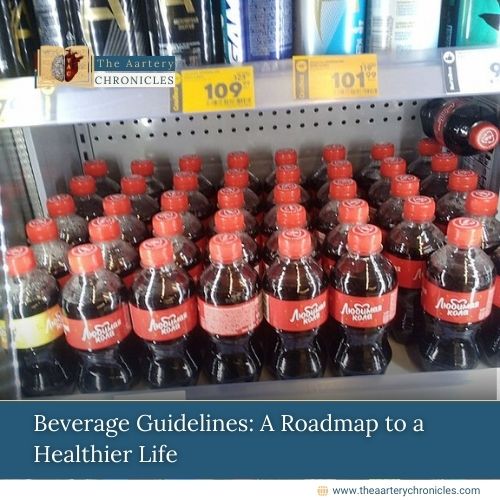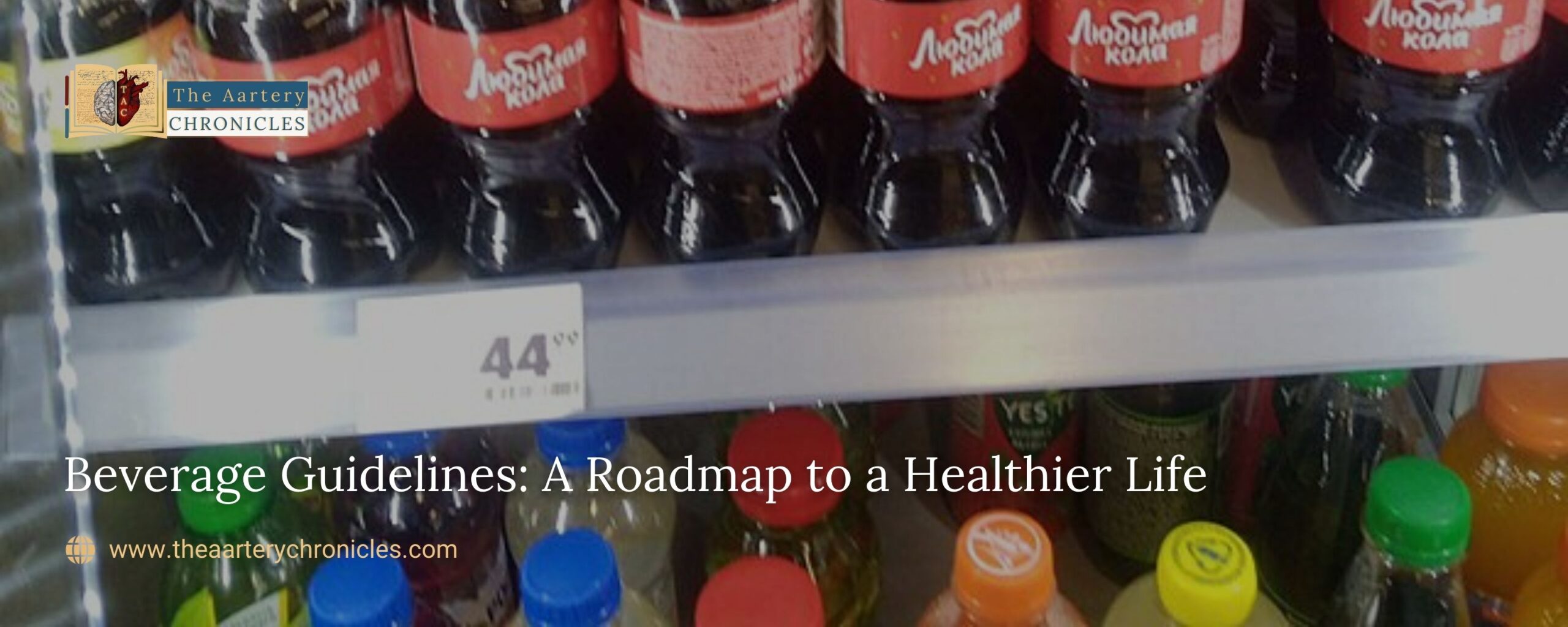

Beverage Guidelines: A Roadmap to a Healthier Life
Introduction
In the quest for a healthier lifestyle, wellness beverages have surged in popularity. These drinks offer more than just hydration; they provide functional benefits like enhanced gut health, improved mental clarity, and better immune function. With the expanding market for these beverages, it’s crucial to understand their benefits and how to incorporate them into a balanced diet.
Historically, humans relied solely on water for hydration for millions of years. With the advent of agriculture and animal domestication, milk became a staple, followed by beverages such as beer, wine, coffee, and tea, enjoyed for both hydration and pleasure. Modern beverages like soft drinks, sports drinks, and energy drinks also provide hydration but often come with added, unnecessary calories. [1]
With so many beverage options and their varying health impacts, confusion about the healthiest choices is common. This led to the formation of the independent Beverage Guidance Panel, including experts like Dr. Walter C. Willett from Harvard’s School of Public Health. The panel evaluated beverages based on calories, nutrient contribution, and health effects, ranking them into six levels. Water emerged as the top choice. Although it is neither the only healthy beverage nor is there a strict need for everyone to drink eight glasses daily. This article explores the variety of wellness beverages available today and provides guidelines for making the best choices for your health. [1]
Beverage Guidelines from the Experts
The Beverage Guidance Panel distilled its advice into a six-level pitcher, similar to the food pyramid. The recommendations were published in the March 2006 edition of the American Journal of Clinical Nutrition. [2]
Here is a summary of each level:
Level 1: Water
Water is essential for replenishing fluids lost through metabolism, breathing, sweating, and waste removal. It’s the ideal beverage for quenching thirst and rehydrating. The Institute of Medicine suggests an adequate intake of about 125 ounces (15 cups) for men and 91 ounces (11 cups) for women daily, though these amounts can vary based on diet, weather, and activity levels. About 80% of this intake typically comes from beverages, with the rest from food. The common advice to “drink eight glasses of water a day” is a practical way to meet most fluid requirements, although it is not a strict rule. [1, 3]
Level 2: Tea and Coffee
After water, tea and coffee are the world’s most widely consumed beverages. When consumed plain, they are calorie-free and rich in antioxidants, flavonoids, and other biologically active compounds that can be beneficial to health. Green tea, particularly the strong Japanese variety, has been noted for its potential to reduce the risk of heart disease, while coffee may offer protection against type 2 diabetes. Although more research is needed to fully understand the health benefits of tea and coffee, it’s clear that adding cream, sugar, whipped cream, and flavourings can transform these healthy beverages into not-so-healthy options. [1, 4, 5]
While most teas offer health benefits, many varieties have their own unique advantages. Some healthy tea options include:
- Green tea: Green tea may promote heart health and reduce the risk of type 2 diabetes. [6, 7]
- Black tea: Black tea has been suggested to support cognitive health and improves heart health. [8]
- Oolong tea: Oolong tea combines the benefits of green and black teas. It may aid in weight loss and maintain healthier cholesterol levels. [9]
- Chamomile tea: Chamomile tea can help with relaxation, improve sleep quality, and soothe digestive issues like indigestion and bloating. Additionally, it may even have anti-inflammatory properties, aiding in conditions like menstrual cramps. [10]
Level 3: Low-Fat, Skim Milk, and Soy Beverage
For children, milk is a crucial source of calcium and vitamin D. Fortified soy milk is a good alternative for those who avoid cow’s milk. Both provide protein and essential micronutrients. Low-fat (1% or 1.5%) and skim milk are preferable due to their lower saturated fat content. High milk consumption, even low-fat, may increase cancer risks, so adults should limit intake to one or two glasses daily, ensuring calcium comes from other sources. For growing children, the optimal amount of milk and calcium is uncertain, but limiting milk intake to no more than two glasses per day seems to offer adequate nutrition without being excessive. [1]
Level 4: Non-Calorically Sweetened Beverages
Diet sodas and other diet drinks contain calorie-free artificial sweeteners like aspartame, saccharin, sucralose, and stevia. These beverages are lower in calories compared to sugar-sweetened soft drinks, making them a preferable choice for calorie-conscious individuals. However, there is a concern that they may still contribute to weight gain. Therefore, they should be consumed occasionally rather than as a daily beverage. For those struggling to quit regular soda, diet drinks can serve as a transitional option towards healthier beverage choices. [1]
Level 5: Caloric Beverages with Some Nutrients
This category includes
- Fruit juice
- Vegetable juice
- Whole milk
- Sports drinks
- Vitamin-enhanced waters
- Alcoholic beverages.
Each has benefits and drawbacks. For instance, 100% fruit juice provides nutrients but is calorie-dense. Vegetable juice, though a lower-calorie option than fruit juice, is often high in sodium. Sports drinks are only necessary for endurance athletes, while vitamin-enhanced waters are unnecessary for those who take multivitamins. Alcohol can have benefits but also pose risks, necessitating careful consideration. [1]

Level 6: Calorically Sweetened Beverages
Beverages sweetened with sugar or high-fructose corn syrup, such as soft drinks, fruit drinks, and lemonade, offer high calories with little nutritional value. These drinks can contribute to weight gain and increase the risk of type 2 diabetes. They are best consumed sparingly, if at all. [1]
A Sample Beverage Plan: A Guide Curated by Experts
To help individuals navigate beverage choices, the Beverage Guidance Panel created a visual representation, similar to the food pyramid, to illustrate a balanced approach to beverage consumption. Here’s a suggested plan for someone requiring 2,200 calories a day, aiming to get less than 10% of their daily calories from beverages:
- Water: Make water your primary beverage. Aim for at least half of your daily fluid intake to come from water. For instance, if you need 12 cups of fluid per day, consume six cups of water. You can drink even more water, fulfilling all your beverage needs.Your body would be completely satisfied if you consumed only water.
- Unsweetened Coffee or Tea: About one-third of your daily fluid intake, roughly three to four cups, can be derived from unsweetened coffee or tea. If you prefer flavored coffee or tea with sugar or cream, consider reducing consumption or opting for water instead.
- Low Fat milk: Incorporate low-fat milk, equivalent to 20% of your daily fluid intake, which could be around two 8-ounce glasses. Ensure you obtain calcium from alternative sources if you consume less milk.
- 100% Fruit Juice: Include a small glass (4 ounces) of 100% fruit juice in your beverage plan.
- Alcoholic Drinks: Limit alcoholic drinks to no more than 1 to 2 for men or 1 for women.
- Diet Drinks: Ideally, avoid diet drinks containing artificial sweeteners. However, if you choose to consume them, limit your intake to 1 to 2 glasses (8 to 16 ounces) a day.
- Sugary Drinks: Ideally, avoid drinks sweetened with sugar or high-fructose corn syrup. If consumed, limit intake to a maximum of 8 ounces.
This plan provides guidance on balancing beverage choices to ensure optimal hydration and nutrition.
Conclusion
In conclusion, wellness beverages offer a convenient and enjoyable way to enhance your health. By understanding the benefits of different types of drinks and following consumption guidelines, you can make informed choices that contribute to a balanced and healthy lifestyle.
- Healthy Beverage Guidelines – The Nutrition Source (harvard.edu)
- A new proposed guidance system for beverage consumption in the United States - PubMed (nih.gov)
- Front Matter | Dietary Reference Intakes for Water, Potassium, Sodium, Chloride, and Sulfate | The National Academies Press
- Green tea consumption and mortality due to cardiovascular disease, cancer, and all causes in Japan: the Ohsaki study - PubMed (nih.gov)
- Coffee, caffeine, and risk of type 2 diabetes: a prospective cohort study in younger and middle-aged U.S. women - PubMed (nih.gov)
- Dietary Polyphenols, Mediterranean Diet, Prediabetes, and Type 2 Diabetes: A Narrative Review of the Evidence - PMC (nih.gov)
- Green tea consumption and incidence of cardiovascular disease in type 2 diabetic patients with overweight/obesity: a community-based cohort study - PMC (nih.gov)
- 6 health benefits of drinking black tea | UCLA Health
- Reduced risk of dyslipidaemia with oolong tea consumption: a population-based study in southern China | British Journal of Nutrition | Cambridge Core
- 13 Benefits of Chamomile Tea - Healthy Focus





